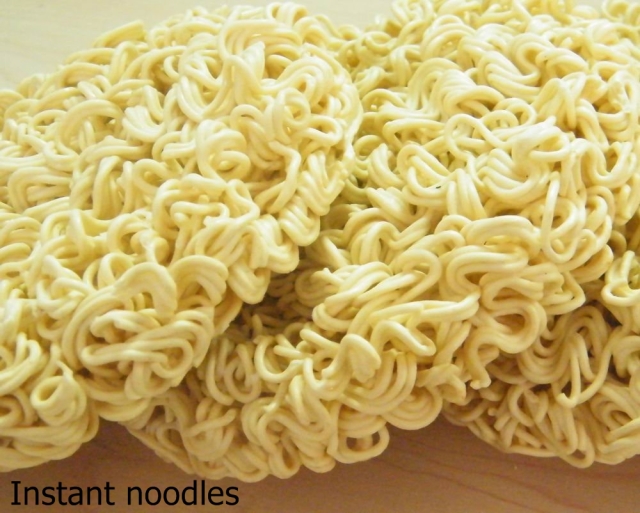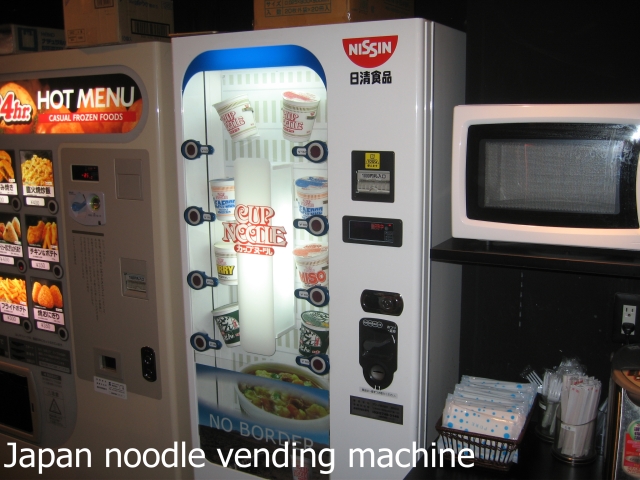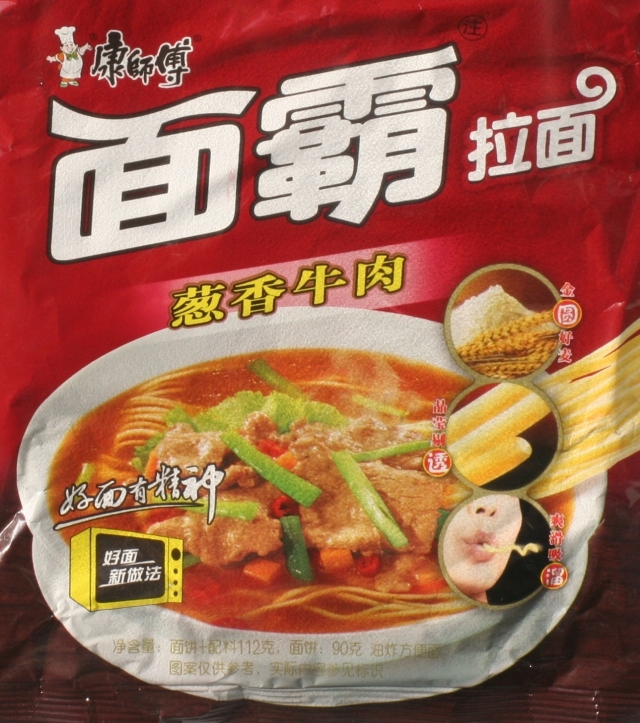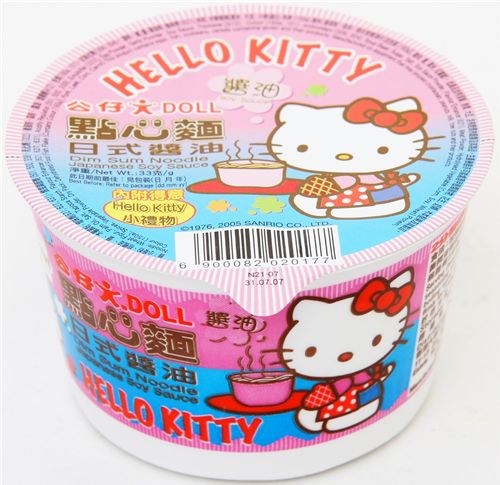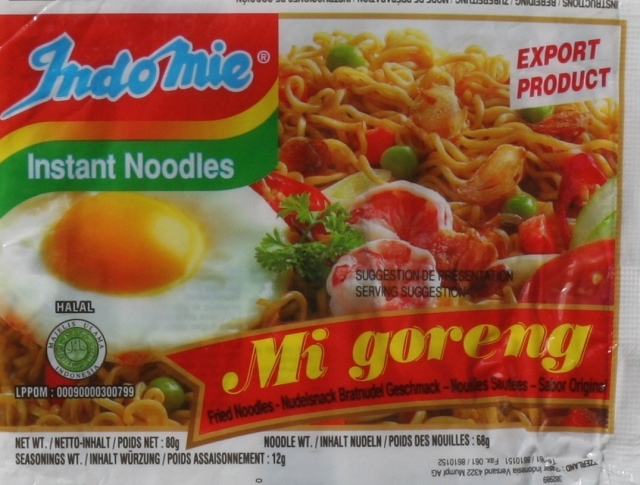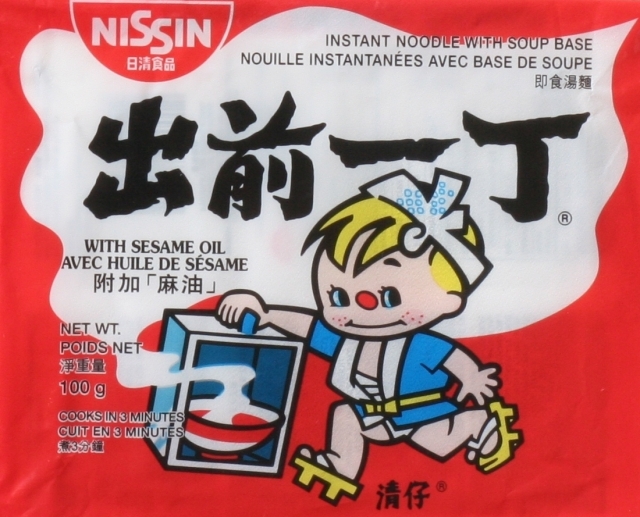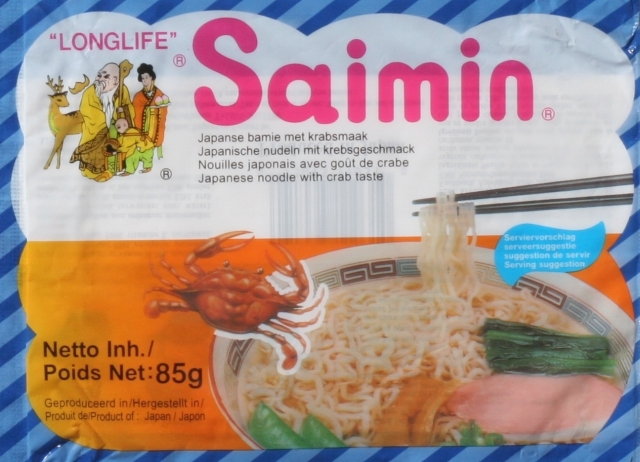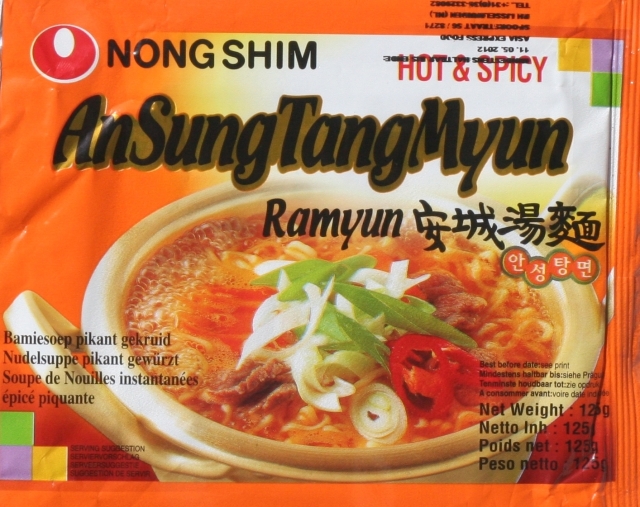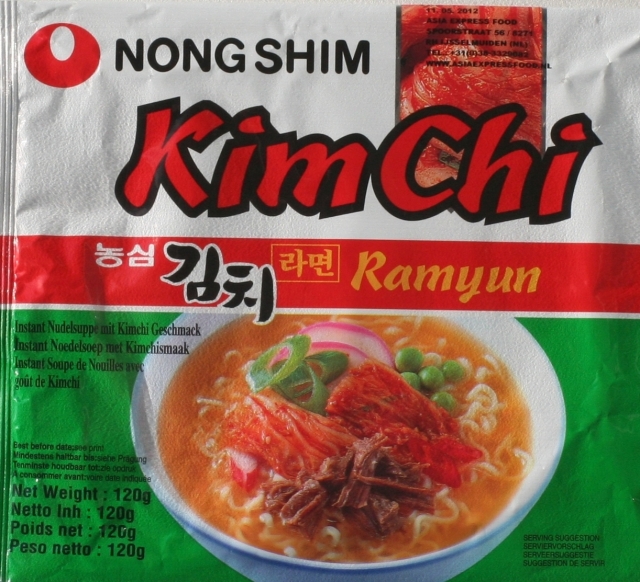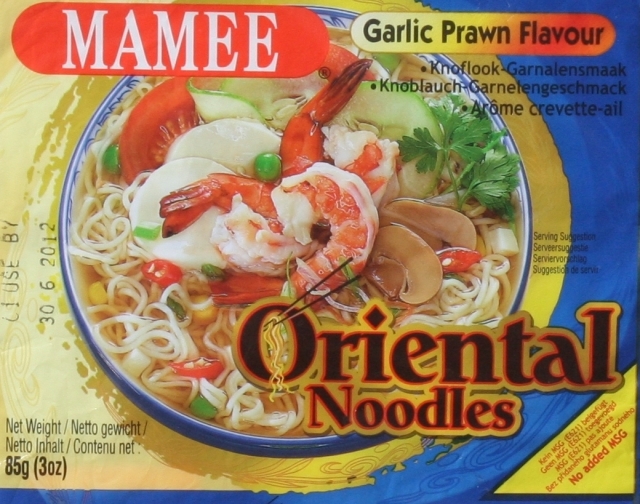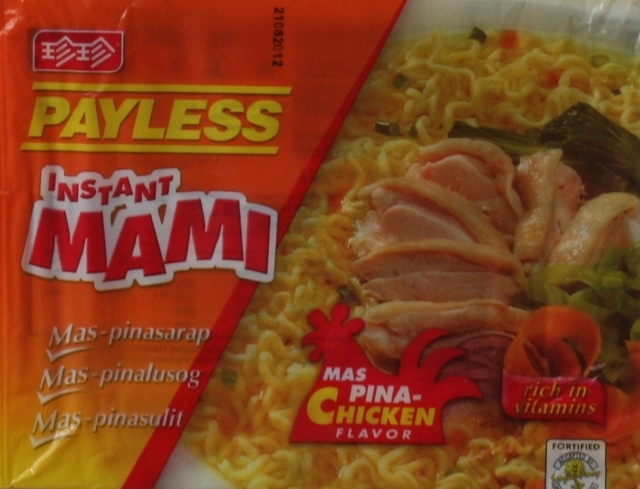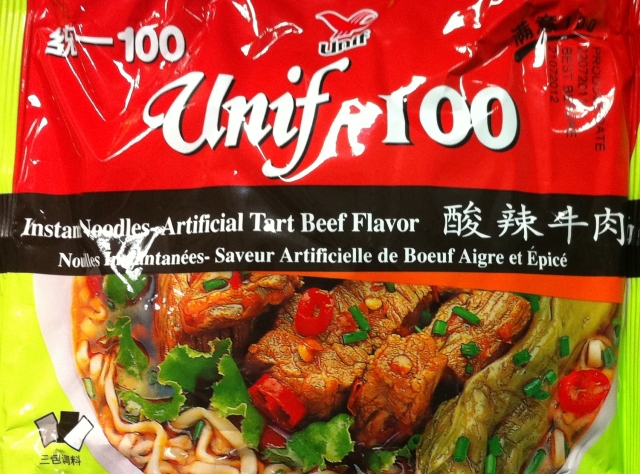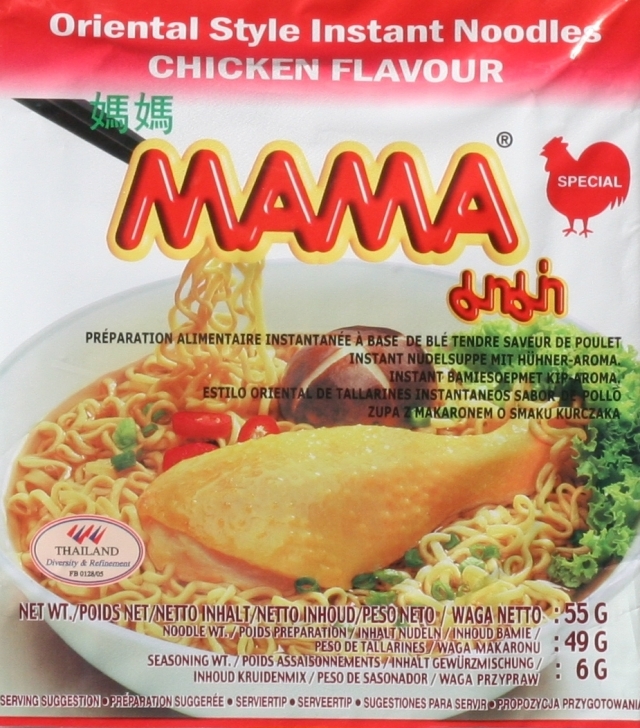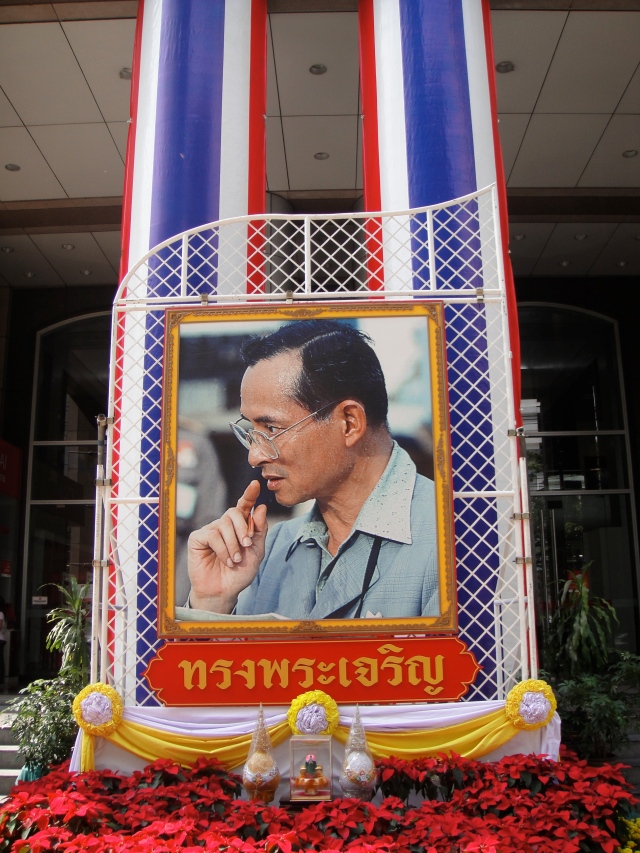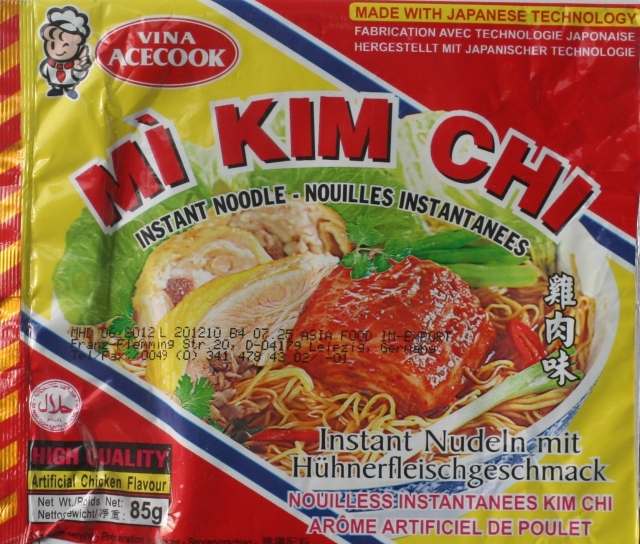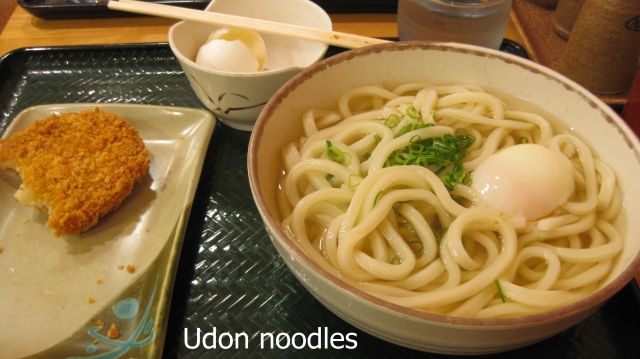Instant noodles are dried or precooked noodles and are often sold with packets of flavoring including seasoning oil. Dried noodles are usually eaten after being cooked or soaked in boiling water for 2 to 5 minutes[citation needed], while precooked noodles can be reheated or eaten straight from the packet. Instant noodles were invented by Momofuku Andō of Nissin Foods, Japan.
Instant noodles were first created by Momofuku Ando, who was born in southwestern Taiwan when the island was under Japanese colonial rule, in Japan on August 25, 1958, under the brand name Chikin Ramen (チキンラーメン). Momofuku developed the production methodology of flash frying the noodles after they had been made, creating “instant” noodles. This step dried the noodles and gave them a longer shelf life. Chikin Ramen itself was distinctly different from modern instant noodles in that each block of noodles was pre-seasoned and sold for 35 Yen. Initially, due to its price and novelty, Chikin Ramen was considered a luxury item, as Japanese grocery stores typically sold fresh noodles for one-sixth their price. Despite this, instant noodles eventually gained immense popularity, especially after being promoted by Mitsubishi Corporation.

In 1971, Nissin introduced the Cup Noodles, instant noodles in a waterproof polystyrene cup, to which boiling water could be added to cook the noodles. A further innovation added dried vegetables to the cup, creating a complete instant soup dish.According to a Japanese poll in the year 2000, “the Japanese believe their best invention of the 20th century was instant noodles.” As of 2010, approximately 95 billion servings of instant noodles are eaten worldwide every year. China consumes 42 billion packages of instant noodles per year – 44% of world consumption – Indonesia, 14 billion; Japan, 5.3 billion, Viet Nam 4.8 billion, USA 4 billion. Per capita, South Koreans consume the greatest amount of instant noodles, 69 per capita per year.
Instant noodles are not only popular with college students, they can also be an economic indicator. In 2005, the Mama Noodles Index was launched to reflect the sales of Mama Noodles, the biggest instant noodle manufacturer in Thailand. The index was steady following recovery from the 1997 Asian Financial Crisis, but sales increased about 15% on a year-to-year basis in the first seven months of 2005, which was regarded as a sign of an inferior good, one whose consumption increases as incomes fall. The theory was that the increase in sales of instant noodles, which are usually cheap, occurred because people could not afford more expensive foods.
Health concern:
Instant noodles are often criticized as unhealthy or junk food. A single serving of instant noodles is high in carbohydrates but low in fiber, vitamins and minerals. Noodles are typically fried as part of the manufacturing process, resulting in high levels of saturated fat and/or trans fat.[citation needed] Additionally, if served in an instant broth, instant noodles typically contain high amounts of sodium. The current U.S. Recommended Dietary Allowance of sodium for adults and children over 4 years old is 2,400 mg/day; in extreme cases, some brands may contain over 3,000 mg of sodium per package.
The most recent controversy concerns dioxin and other hormone-like substances that could theoretically be extracted from the packaging and glues used to pack the instant noodles. It was reasoned that harmful substances could seep into the soup as hot water was added to cup style instant noodles. After a series of studies were conducted, various organizations requested changes in the packaging to address these concerns. Another concern regarding the consumption of fried foods, including instant noodles, is the possible presence of oxidation products resulting from poor maintenance of the oil. If the cooking oil is not maintained at the proper temperature or changed as often as necessary, these oxidation products, which are suspected to pose various health risks, can be present in the foods. Proper production standards minimize the risk.
China:
China is a fast-growing market for instant noodles. The market is focusing on higher-end products, generally costing more than 1 RMB. The top three brands in this category dominate more than 85% of the market; for the lower end, those costing less than 1 RMB, the leading five brands hold about 60% of the market share.
The dominant brands in the Chinese market are:
Ting Yi (aka Master Kong or Kang-shi-fu, 康師傅), owned by the Taiwanese Tingyi (Cayman Islands) Holding Corporation and managed with a Japanese strategic alliance partner Sanyo Food, the third-largest player in the Japanese market. Master Kong is the largest brand, with a business scope extending to beverages (RTD) and bakeries.
Uni-President , a PLC listed in Taiwan. Like Master Kong, it once had its own businesses in beverages and bakeries. However, the company recently formed a JV partnership with Hwa-Long and Nissin to distribute beverages. Uni-President’s home market is Taiwan, but the company is now expanding aggressively in mainland China.
Hwa-Long (華龍, i.e. Chinese Dragon), a local company allied with Nissin. Because of that relationship, Hwa-long has long been regarded as Nissin’s agent in the world’s largest consumer market. Recently Hwa-long, Nissin, and Uni-President formed a partnership in the beverage business in order to collectively compete against Master Kong.
Bai-xiang (白象, i.e. White Elephant), a local company spin-off based on a former state-owned enterprise, which still enjoys a strong local customer base. It is a leading brand in terms of volume, and its products fall into the lower price range.
Hong Kong:
Cantonese people have a long history of cooking yi mein, a noodle invented in the Qing Dynasty. Modern instant noodles were publicly introduced as “Doll Noodles” in the late 1960s by Winner Food Products Ltd, which was bought by Nissin in 1984. That term has since become a synonym for instant noodles irrespective of brand in Hong Kong and Southern China. Other brands include Shin Ramyun and Demae Itcho.
Indonesia:
With production peaking at 8.66 billion packs in 1996, Indonesia is the second largest producer of instant noodle after China which produces 16 billion packs a year. The first widely known instant noodle in Indonesia was “Supermi”, introduced in the 1970s by Indofood Sukses Makmur, the largest instant noodle producer in the world. It later introduced two additional brands – “Indomie” and “Sarimi”.
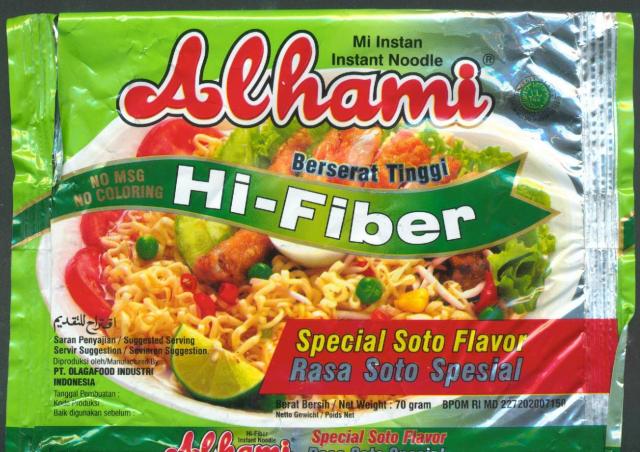
Currently, Indofood Sukses Makmur has a market share of about 70% of Indonesian instant noodle production. In 1999, the figure was about 90%; their market share declined following the introduction of “Mie Sedaap” by Wings Food in 2003. Indonesians prefer noodles with a strong flavor. Popular flavors of Indonesian instant noodle include Chicken Curry, Onion and Chicken, Beef Meatball, and Chicken Soto, a traditional Indonesian chicken soup. In the past, Indomie tried to produce 30 different flavors to reflect various traditional dishes of Indonesian cuisine, but the product line was discontinued after disappointing results with only several popular variants remain in production. Strong local preferences contribute to the low volume of sales of Japanese and other foreign instant noodles in Indonesia; hot and spicy Korean noodles appeal most to these tastes and have the largest market share among foreign instant noodles. A dry instant noodle meant to replicate the traditional Indonesian dish Mi Goreng, or fried noodle, is also popular in Indonesia. Most of the market share is owned by the product Indomie Mi Goreng.
Japan:
Japan is the country of origin of instant noodles. Instant noodles remain a “national” light food. The average Japanese person eats 40 packs of instant noodles per year. After their invention by Taiwanese-Japanese Momofuku Andō in 1958, instant noodles became very common in Japan. In the 1970s, makers expanded their flavors to include such examples as shio (salt ramen), miso, or curry. Beginning in the 1980s, makers also added dried toppings such as shrimp, pork, or eggs. This, however, made instant noodles more expensive,[citation needed] and their popularity decreased for a while. Today, instant noodles are divided into two groups: “traditional” cheap (¥150 to ¥200) noodles with few toppings and expensive (¥200 to ¥500) noodles with many toppings, which are often packed into a pouch. Various kinds of instant noodles are produced, including ramen, udon, soba, yakisoba, and pasta.
Major makers in Japan are:
Nissin Food Products 清食, whose famous brands include Chicken Ramen and Cup Noodles, has a 40.4% market share As of 2005.
Tōyō Suisan 東洋水産, nicknamed Maruchan, whose brands include Akai Kitsune and Midori no Tanuki, has a 19.2% market share.
Sanyō Foods サンヨー食, Sapporo Ichiban, has a 11.5% market share.
Myōjō Foods 明星食, Charumera, has a 9.9% market share.
Acecook エースコック, Super Cup, has a 8.3% market share.
Korea:
Per capita, South Koreans consume the greatest amount of instant noodles, 69 per capita per year. In the 1960s, instant noodle became popular in South Korea, and its quick and easy preparation and cheap price made it quickly popular. In South Korea, instant noodles are more common than non-instant noodles; the word ramyeon (라면), generally means the instant kind. Most South Korean food stalls make instant ramyeon and add toppings for their customers. Instant ramyeon is also often added to budae jjigae (literally “army base stew”), a stew made with assorted ingredients, which was invented in the 1950s in South Korea.
Ramyeon is typically spicy. Shin Ramyun (신[辛], literally “spicy”) is the best-selling brand in Korea. It has also become popular in China and the United States. The leading manufacturer of ramyeon in Korea is the Nong Shim company, which exports many of its products overseas. In 2004, over 600,000 boxes of Shin brand Ramyeon were sent to North Korea as part of the aid relief program when Ryongchŏn train station exploded, injuring many North Korean civilians. However, insider sources state that most of it was sold in North Korean black markets, making its way to Pyongyang, instead of distributed as aid. North Korean visitors to China also frequently purchase South Korean ramyeon from Chinese stores, where Shin Ramyeon is known as “Korean Tangmi Ramyeon”.
Indigenous production of Ramyeon in North Korea began in 2000. The first Ramyeon brand was “kkoburang guksu”, which literally means curved noodles in Korean. Later, a joint venture by North Korean and Hong Kong-based companies began producing “jeukseok guksu” (즉석 국수), which literally means “instant noodles”. Ramyeon are popular among North Korean elites who live in Pyongyang and Nampo. In contrast to hot and spicy South Korean Ramyeon, North Korean Ramyeon has a much milder and brothier flavor.
Malaysia and Singapore:
Maggi has practically become synonymous with instant noodles. Curry is a favorite flavor; other popular flavors include chicken, tom yum, and asam laksa. Both soup-based and dry variants are readily available. Indomie, Nissin, Cintan and Mamee brands of instant noodles are also well-loved by both Malaysians and Singaporeans. Though instant noodles are usually eaten at home, they are also becoming increasingly popular as restaurant or cafe meals, especially in Hong Kong-themed “cha chan teng” cafes and “Mamak” food shops. These meals are usually modified according to the chef’s taste and include minimal monosodium glutamate. In recent years, instant noodles manufacturers have tried to introduce low-MSG seasonings.
Philippines:
There are many local and imported brands of instant noodles in the country, which are locally known as “instant mami”, after the Philippine version of chicken noodle soup. Brands in the Philippines include Lucky Me, Payless, Nissin, QuickChow, and Ho-Mi. They are sold in packets, sealed cups or sealed styrofoam bowls. Because of their fast preparation and affordability, instant noodles are popular as a quick snack or for breakfast. Filipinos sometimes add a scrambled egg into the chicken noodle soup while cooking it. Another popular variation is the instant pancit canton, stir-fried noodles resembling the local pancit. These noodles are boiled and drained, then a flavoring powder, soy sauce, oil and bits of carrot and celery are added.
Taiwan:
Instant noodle inventor Momofuku Andō (安藤百福) was born in Taiwan. According to statistics from the International Ramen Manufacturers Association, Taiwan is the world’s 12th largest instant noodle market, with an annual NT$10 billion (US$300 million) in sales. This translates into an annual total of 900 million packs, or 40 per person.[29] Uni-President (aka President or Tong-Yi, 統 takes the largest market share of instant noodles in the country, and is a major player in the global instant noodle market. The most popular flavors in Taiwan are beef noodle soup and minced pork noodle.
Thailand:
The most popular instant noodle in Thailand is “Mama” or dindin cup noodles; Tom Yum Shrimp is the favorite flavor. Other local players in the market include the Wai Wai and Yum Yum brands. Due to their ubiquity, instant noodles were chosen as a vehicle for dietary fortification by a joint effort of the Federation of Thai Industries, instant noodle producers, and the Ministry of Public Health about 10 years ago. The vitamins and minerals added are iron, iodine and vitamin A. Unlike Japanese or Malaysian instant noodles, Thai noodles are seasoned with chicken stock before frying, giving them extra flavor, and they are sometimes consumed directly as a snack without further cooking. Instant noodles have spread all over Thailand, and now include real dehydrated meat such as pork and beef.
Vietnam:
Instant noodles are popular in Vietnam, where they are often eaten as a breakfast food. Both wheat and rice noodles are common. Acecook Vietnam JSC is a leading producer of instant noodles. Another major producer and exporter is Vifon. Popular Vietnamese instant noodle soups include Oriental, Bún bò Huế flavored, Phở and Hủ tiếu Nam Vang, a Phnom Penh-style noodle.
